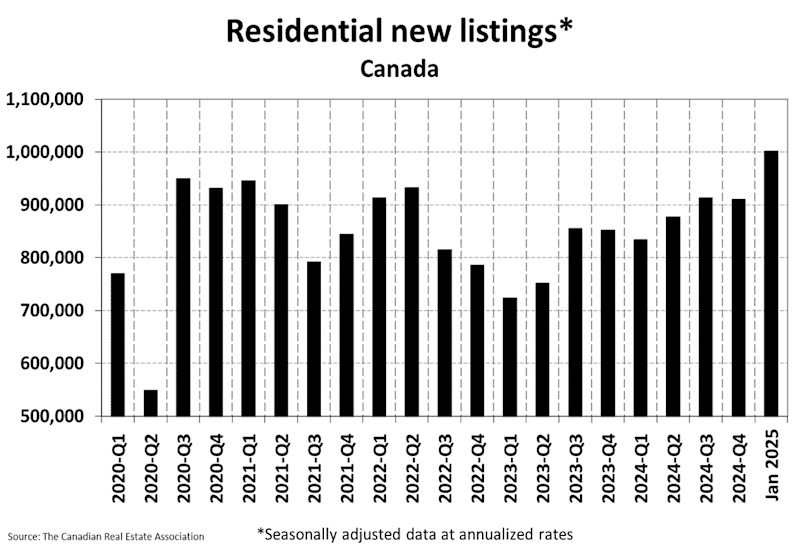The Canadian housing market saw a significant increase in new listings in January 2025, offering more choices for homebuyers. However, this positive trend is being met with uncertainty due to potential U.S. tariffs on Canadian goods, which could impact construction costs and home affordability.
Let’s dive into the key market trends and what they mean for buyers, sellers, and real estate professionals.
1. Surge in New Listings: A Buyer’s Market?
January saw a double-digit increase in new property listings compared to the previous month. More listings generally mean a balanced market, giving buyers better negotiating power.
Here’s a look at the trend in new listings over the past few months:
New Property Listings in Canada (Oct 2024 - Jan 2025)
The chart above shows a significant increase in new listings in January 2025, which suggests a potential shift toward a buyer’s market.
2. U.S. Tariff Uncertainty and Its Impact on Housing Costs
While more listings are good news, the Canadian real estate market faces a new challenge—potential U.S. tariffs. The U.S. administration has proposed tariffs of up to 25% on Canadian goods, which could have a direct impact on:
Construction Costs: Higher lumber and material costs may lead to increased home prices.
Builder Activity: Developers may slow down projects due to uncertainty.
Home Affordability: Rising costs could offset the benefits of more listings.
Here's a visual of the potential impact on construction costs.
Projected Increase in Construction Costs Due to Tariffs
The chart above highlights the projected cost increases in lumber, steel, and concrete, which could raise overall construction expenses by 12% or more. This means new home builds may become more expensive, affecting both buyers and developers.
3. Bank of Canada’s Response: Interest Rate Cuts
In response to economic uncertainty, the Bank of Canada has lowered interest rates to 3%, aiming to stimulate borrowing and economic activity. This move is meant to:
✅ Encourage home buying by reducing mortgage rates
✅ Offset rising costs from tariffs
✅ Support economic growth amid trade uncertainties
Interest Rate Trends (2024 - 2025)
The chart above shows a steady decline in interest rates, with a significant drop to 3% in January 2025. Lower rates can make mortgages more affordable, but inflationary pressures from tariffs could complicate things.
What This Means for Buyers and Sellers
📌 For Buyers:
More listings mean better selection and potential price stabilization.
Lower interest rates make mortgages more affordable.
However, if construction costs rise, new home prices could increase.
📌 For Sellers:
More listings mean higher competition, so pricing strategically is key.
If tariffs slow down new construction, existing homes may hold value better.
Buyers are still active, but affordability concerns could impact demand.
Final Thoughts
The Canadian real estate market is experiencing both opportunities and risks in early 2025. While more listings and lower interest rates create a favorable environment for buyers, potential U.S. tariffs could disrupt market stability. Staying informed and working with experienced real estate professionals will be crucial in navigating these changing conditions.
📢 Are you looking to buy or sell?
Let’s chat! I can help you make the right real estate moves in this evolving market. 🚀

























